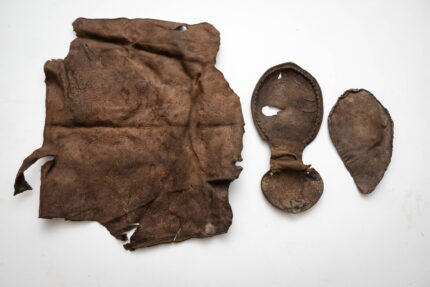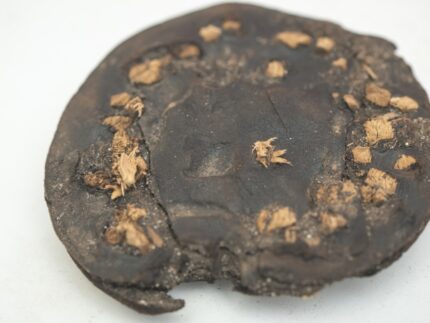 Archaeologists have uncovered the largest collection of 16th-17th century fabrics and footwear in Europe at a construction site in Toruń, Poland. The collection includes entire shoes in both eastern and western styles, fragments of pleated dresses, neckline trim, woolen stockings, very expensive gold cloth and silk.
Archaeologists have uncovered the largest collection of 16th-17th century fabrics and footwear in Europe at a construction site in Toruń, Poland. The collection includes entire shoes in both eastern and western styles, fragments of pleated dresses, neckline trim, woolen stockings, very expensive gold cloth and silk.
Toruń was one of the most important cities in the Hanseatic League. It was the fulcrum of a vast trade network throughout Europe and the Near East. With access to the best raw materials, Toruń developed a highly-skilled and varied community of cratsmen to create the best quality products made of horn, metal, ceramics, fabric and leather for sale to the wealthy and elites of Europe.
 The site was being excavated in advance of construction of a new film studio when footwear was found in a trench. There were shoes that would have been worn by the working class and footwear that could only have been afforded by the wealthy. Spur mounts on high boots point to them having belonged to military officers. The fragments of silk and gold cloth were imported from Turkey or Persia, and were extremely costly. Previous to this find, silk had only been found in the crypts of churches, most of them small fragments. The pieces found in this dig are much larger. A lady’s woolen glove lined with silk is so fine it is comparable only to liturgical gloves found in the graves of bishops.
The site was being excavated in advance of construction of a new film studio when footwear was found in a trench. There were shoes that would have been worn by the working class and footwear that could only have been afforded by the wealthy. Spur mounts on high boots point to them having belonged to military officers. The fragments of silk and gold cloth were imported from Turkey or Persia, and were extremely costly. Previous to this find, silk had only been found in the crypts of churches, most of them small fragments. The pieces found in this dig are much larger. A lady’s woolen glove lined with silk is so fine it is comparable only to liturgical gloves found in the graves of bishops.
The workmanship and materials in some pieces from the collection are so fine that you’d expect to find them only in the city where wealthy townspeople could buy them, but when this collection was deposited, it was in a suburb of Toruń. Similar finds in the suburbs of Gdańsk, for example, are of much lower quality and cost.
 The quantity of items is also remarkable. Woolen stockings, for example, when they survive at all are usually found individually. There were 11 wool stockings found in this group, and three quarters of them were in an excellent state of preservation. The shoes and textiles all show signs of wear, and the fact that scraps were being collected suggests they may have belonged to a shoemaker’s workshop and a clothes repair shop in the area.
The quantity of items is also remarkable. Woolen stockings, for example, when they survive at all are usually found individually. There were 11 wool stockings found in this group, and three quarters of them were in an excellent state of preservation. The shoes and textiles all show signs of wear, and the fact that scraps were being collected suggests they may have belonged to a shoemaker’s workshop and a clothes repair shop in the area.